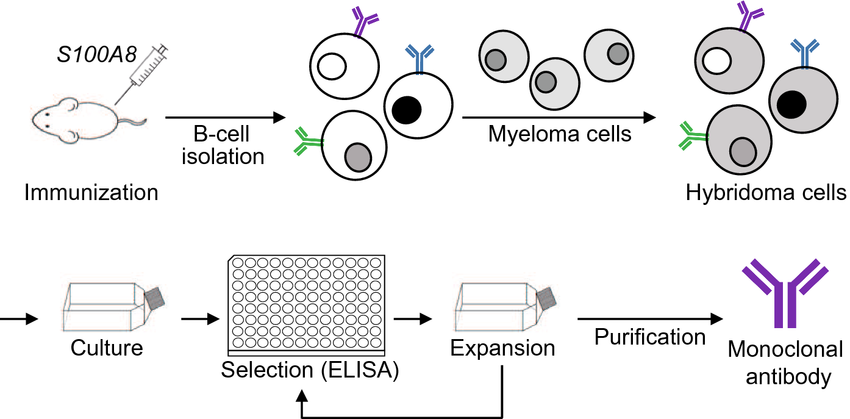2025-04-14 Hits(80)
Antibody Production
Introduction to Monoclonal Antibodies
Monoclonal Antibody (mAb) is a highly uniform antibody produced from the cloning of a single B cell that targets only a specific epitope. Compared with traditional polyclonal antibodies, monoclonal antibodies have higher specificity and uniformity. Monoclonal antibodies can be produced in large quantities and can be prepared in large quantities by cell culture. Monoclonal antibody technology is important tools in biomedical research, disease diagnosis and the treatment of certain diseases, such as infectious diseases and cancer.
Monoclonal antibodies production methods include hybridoma technology and phage display technology. Hybridoma technology is the most commonly used method to prepare hybridoma cells by cell fusion. Phage display technology uses genetic engineering technology to insert antibody genes into phages and obtain specific antibodies through screening.
Principle and Process of Producing Monoclonal Antibody
(1) Hybridoma antibody production
Hybridoma cells were formed by fusion of antibody-producing B cells with myeloma cells that proliferate in vitro by cell hybridization. The hybridoma cells have both the characteristics of B-cell synthesis of specific antibodies and the characteristics of myeloma cell proliferation in vitro, so that a large number of monoclonal antibodies against specific antigenic domains can be prepared. Detailed steps are as follows:
① Immunizing animals: Immunizing mice with the target antigen causes the mice to produce sensitized B lymphocytes. Generally, female Balb/c mice aged 6-8 weeks were selected for immunization according to the pre-established immunization schedule.
② Cell fusion: Mice were killed, spleen was removed, and splenic cell suspension was prepared. The spleen cells and myeloma cells were mixed in a certain proportion, and the fusion promoter polyethylene glycol was added to promote the fusion of the cells to form hybridoma cells.
③ Selective culture: HAT selective medium was used to screen fused hybridoma cells. Unfused myeloma cells and lymphocytes gradually die, and only fused hybridoma cells survive and proliferate in the medium.
④ Screening and cloning of hybridoma positive clones: hybridoma cells secreting specific monoclonal antibodies were screened and cloned.
⑤ Antibody detection and purification: Antibodies secreted by hybridoma cells are detected and purified.

Figure 1:Schematic representation of monoclonal antibody production using hybridoma technology[2]
Phage display technology is an efficient gene expression screening technology, which fuses foreign proteins or peptides with specific phage capsid proteins, displays them on the phage surface and maintains relatively independent spatial conformation and biological activity, which is conducive to the specific recognition and binding of target molecules, so as to realize the unity of genotype and expression type[3].
Phage display technology is to insert the gene encoding exogenous peptides or proteins into the appropriate position of the structure gene of the phage coat protein through genetic engineering technology, so that the gene can be correctly expressed in the reading frame, so that the exogenous peptides or proteins can form fusion proteins on the capsid protein of the phage and be presented on the surface of the phage with the reassembly of the progeny phage. It can maintain relative spatial structure and biological activity. Then the target molecules were used to wash away the unspecifically bound bacteriophages by appropriate panning methods. Then the bound phage is eluted with acid-base or competing molecules, and the neutralized phage infects E. coli with amplification. After 3-5 rounds of enrichment, the proportion of phages that can specifically recognize target molecules is gradually increased, and finally the polypeptide or protein that can recognize target molecules is obtained.
Monoclonal Antibodies Production FAQ
Q1: How to solve sample contamination?
A: This needs to be addressed by optimizing extraction and purification steps and using more stringent sample handling methods, such as chromatography techniques.
Q2: Hybridoma cells grow slowly.
A: It may be due to low fusion efficiency or poor medium conditions that the fusion conditions and medium composition need to be optimized.
Q3: How to choose the right monoclonal antibody production method?
A: The selection of suitable monoclonal antibody production method depends on the sample characteristics, sequencing purpose, equipment conditions and other factors. For example, hybridoma technology is commonly used to produce monoclonal antibodies with specific epitopes; For complex samples or full-length sequencing, mass spectrometry is more suitable.
Q4: How to solve incomplete sequencing?
A: Possibly due to the complexity of antibody sequences or the interference of modified amino acids, it is necessary to combine multiple sequencing methods for validation.
References
[1] Schook L B .Monoclonal antibody production techniques and applications[J].biochimie, 1987.DOI:10.1016/0300-9084(88)90169-1.
[2] Kim J P , Yun H , Kim E J ,et al.Generation of a novel monoclonal antibody against inflammatory biomarker S100A8 using hybridoma technology[J].Biotechnology Letters, 2023.DOI:10.1007/s10529-023-03364-0.
[3] Saw PE, Song EW. Phage display screening of therapeutic peptide for cancer targeting and therapy. Protein Cell. 2019 Nov;10(11):787-807. doi: 10.1007/s13238-019-0639-7. Epub 2019 May 28. PMID: 31140150; PMCID: PMC6834755.